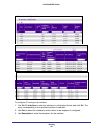
Routing
201
ProSafe M5300 Switch
IPv6
IPv6 is the next generation of the Internet Protocol. With 128-bit addresses, versus 32-bit
addresses for IPv4, IPv6 solves the address depletion issues seen with IPv4 and removes
the requirement for Network Address Translation (NAT), which is used in IPv4 networks to
reduce the number of globally unique IP addresses required for a given network. Its
aggregate addresses can dramatically reduce the size of the global routing table through well
known address combinations. Security is more integrated and network configuration is
simplified yet more flexible.
IPv6 can coexists with IPv4. As with IPv4, IPv6 routing can be enabled on physical and VLAN
interfaces. Each L3 routing interface can be used for IPv4, IPv6, or both. IP protocols running
over L3 (for example, UDP and TCP) do not change with IPv6. For this reason, a single CPU
stack is used for transport of both IPv4 and IPv6, and a single sockets interface provides
access to both. Routing protocols are capable of computing routes for one or both IP
versions.
From the IPv6 link, you can access the following pages:
• Basic on page 201
• Advanced on page 204
Basic
From the Basic link, you can access the following pages:
• IPv6 Global Configuration on page 202
• IPv6 Route Table on page 203


















